| Srl | Item |
| 1 |
ID:
124311
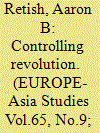

|
|
|
|
|
| Publication |
2013.
|
| Summary/Abstract |
This essay is a study of how Soviet jurists and rural citizens attempted to understand and control illicit social violence during the Civil War and its immediate aftermath in the rural courts. It examines how Soviet leaders, people's courts and criminologists understood the role of the courts in controlling violence and how decisions of local courts actually limited the effects of the violence of revolution and civil war. It underscores the complexity of violence and the need to understand state and peasant attempts to control social violence in an age marked by political, state violence.
|
|
|
|
|
|
|
|
|
|
|
|
|
|
|
|
| 2 |
ID:
128094
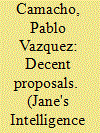

|
|
|
|
|
| Publication |
2012.
|
| Summary/Abstract |
Mexico's problems of violence and drug trafficking by organized crime groups have promoted demands fro change in security policy. Pablo Vazquez Camacho assesses the incoming president's plans for reform and tackling the causes of crime
|
|
|
|
|
|
|
|
|
|
|
|
|
|
|
|
| 3 |
ID:
118556
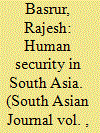

|
|
|
| 4 |
ID:
129401
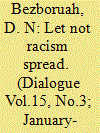

|
|
|
|
|
| Publication |
2014.
|
| Summary/Abstract |
On January 29 this year, Nido Tania, a 19-year-old student from Arunachal Pradesh studying in Delhi was beaten up with iron rods by some traders of Lajpat Nagar after an altercation with a shopkeeper who had made fun of the young student's hairstyle. The post-mortem report shows that his death was caused by severe head and lung injuries. The police have arrested six people whose bail applications have been
turned down. Considering the crime rate in Delhi, this would probably have been written off as just one of those things. After all, India's capital city is witness to several murders, rapes and robberies every day. However, the brutal killing of Nido Tania cannot be dismissed as just one of those things simply because one cannot run away from the fact that he was killed because of the accident of his birth-because someone from Arunachal Pradesh did not look like someone of his age from mainland India. And yet there could be no question of denying his Indian nationality and citizenship.
|
|
|
|
|
|
|
|
|
|
|
|
|
|
|
|
| 5 |
ID:
129402
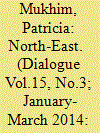

|
|
|
|
|
| Publication |
2014.
|
| Summary/Abstract |
At a time when the discourse among North-Easterners in Delhi is centred around the death of Nido Tania, a student from Arunachal Pradesh, and sharp remarks of racism are flying thick and fast, a central government limping on its last legs has responded with a typical knee jerk reaction by setting up a Committee to look into this so called 'racial prejudice' that visits people from the region regularly like the measles. The Committee comprises an all-male team of retired bureaucrats as if all the wisdom about social and racial prejudices resides with them. That the Home Ministry could notify those names of people of privilege who have never walked in the shoes of the ordinary North- Easterner shopping in the crowded sabzi mandi of Delhi is scandalous. In retrospect this seems like an attempt to quickly shut up the protests and assuage the anger of the people of the region studying, working or living in Delhi.
|
|
|
|
|
|
|
|
|
|
|
|
|
|
|
|
| 6 |
ID:
143325
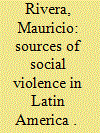

|
|
|
|
|
| Summary/Abstract |
The study of social violence in Latin America has stood at the periphery of cross-national research despite the region being one of the most violent in the contemporary world. This article provides a comprehensive review of theories of crime and presents an empirical analysis of social violence in Latin America from 1980 to 2010. The literature often emphasizes one theoretical approach over others and existing explanations are seen as competitive rather than complementary. Yet, the empirical findings of this study support different explanations and illustrate how considering different theoretical approaches helps improve our knowledge on social violence phenomena. The results from different estimation methods reveal that youth bulges, female workforce, and post-conflict states are positively associated with social violence, as measured by homicide rates. The results also show that states’ efforts to strengthen judicial system capacity and increase school attendance can promote peace. Moreover, while drug producers and/or transit countries are not systematically related to social violence, money-laundering countries experience higher homicide rates, suggesting that not all dimensions of drug-markets increase violence. Whereas Latin America as a whole has experienced few episodes of civil wars in the past decades, the findings suggest that several factors affecting the onset of civil wars also influence other forms of non-political violence such as social violence. This echoes earlier calls in the literature on the necessity of bridging conflict and criminology research.
|
|
|
|
|
|
|
|
|
|
|
|
|
|
|
|
| 7 |
ID:
179365
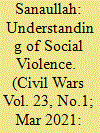

|
|
|
|
|
| Summary/Abstract |
This article discusses debates related to the meaning of violence and proposes the concept of ‘social violence’ to characterise and account for the forms of violence experienced by people in armed conflicts. Drawing on qualitative fieldwork in Pakistan’s Swat Valley, it analyses the social violence wrought by Taliban in 2007-9 and argues that the concept refers to disrespect, humiliation, dishonor and similar actions that damage the identity or reputation of people. Social violence as an analytical concept is a different way of seeing armed conflict, which also offers insights into how civilians are controlled in socially significant ways by insurgents.
|
|
|
|
|
|
|
|
|
|
|
|
|
|
|
|
| 8 |
ID:
129403
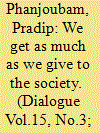

|
|
|
|
|
| Publication |
2014.
|
| Summary/Abstract |
The New Year 2014 is already a month old. The important question for beleaguered Manipur is, would this new beginning have ushered in the start of a fresh year in the true sense of the word? Or would the same vested interests who today have a vicelike grip on the affairs of Manipur, ensure that the dreadful Limbo of the past few decades continues to determine and define life in the State
|
|
|
|
|
|
|
|
|
|
|
|
|
|
|
|
| 9 |
ID:
137225
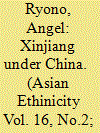

|
|
|
|
|
| Summary/Abstract |
In 2009, a demonstration in Urumqi deteriorated into one of the bloodiest riots in contemporary Chinese history. Some scholars and media groups have responded to the event by focusing public attention on the bottom-up, ethnic, and social aspects of Xinjiang’s conflict phenomenon. This article raises questions and concerns about framing the 2009 event from an ethnic and social standpoint. The authors combine conflict studies with a longue durée historical analysis to argue that multiple dimensions and the intersections of these dimensions constitute the 2009 Urumqi uprising. Present conflict is placed against a backdrop of unequal Chinese state policies with Xinjiang. The authors then forward a Uyghur perspective underpinned by peace and conflict studies concepts. The conclusion recommends conflict prevention strategies by urging the Government of the People’s Republic of China to take ownership of the consequences of its policies and the broken contracts with Uyghur minorities in Xinjiang.
|
|
|
|
|
|
|
|
|
|
|
|
|
|
|
|